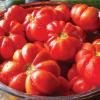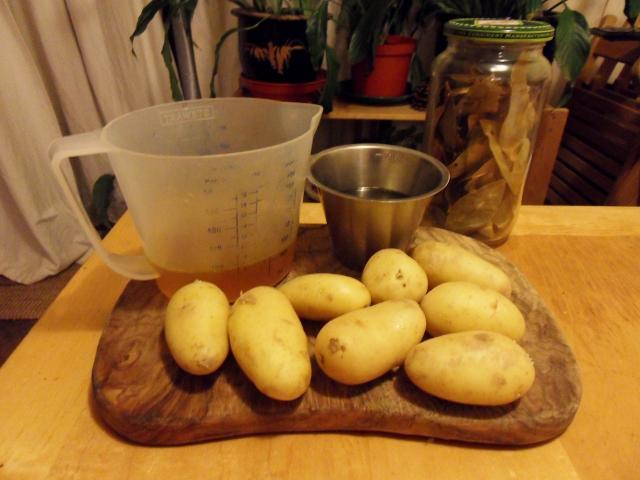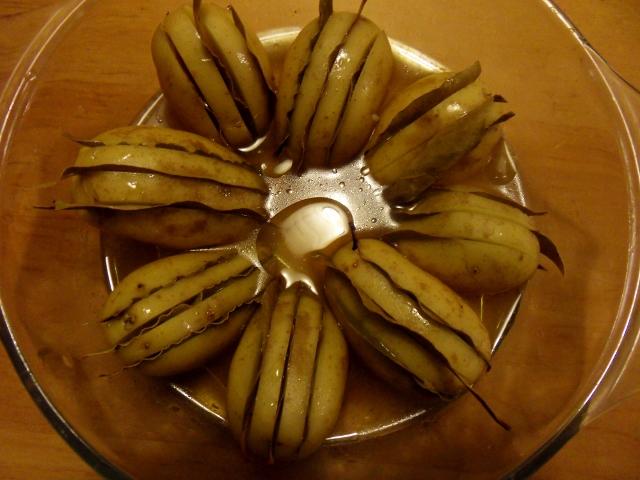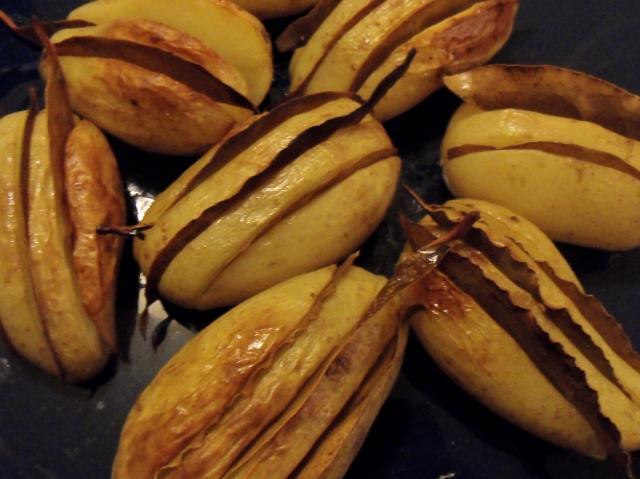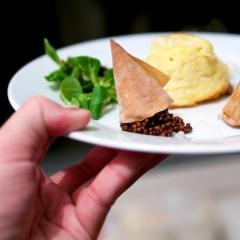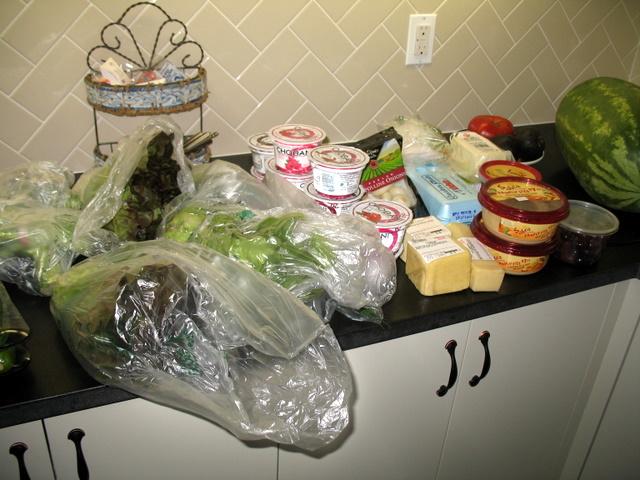Search the Community
Showing results for tags 'Vegetarian'.
-
Hi everyone, Been a while since i've posted much here, but I am again faced with an issue that's plagued me for a while and I'm hoping to get some ideas from you... I like making vegetarian dumplings (the asian potsticker/gyoza type) and can never get the fillings to play nice - they're usually too wet and don't hold together very well, making the construction process frustrating, and the eating process less satisfying than the meat counterpart, in my opinion. There's a certain toothsome-ness that I'd like to be able to achieve, but without the meat that usually brings it. I've improved my process by sweating down vegetables to remove some of the moisture, limiting the liquid seasonings and sometimes used a little cornflour to thicken, but it's still not quite where I'd like it. The fillings vary but often incorporate mushroom or tofu, carrot, cabbage, spring onion etc. I'm wondering if perhaps there's a hydrocolloid/magical modernist powder that might be of assistance... i had some vegetarian dim sum recently that really had that firmish, slightly gelatinous texture. See here for the picture (the two on the LHS), you can probably imagine the feel from that. If something like agar would work, I imagine it could be mixed into a tofu-centric filling that would bind everything a bit more. Any ideas? Even just general technique/tips would be welcome (i.e is there anything similar to the breadcrumbs or flour we put in other things to bind and thicken that would do the job without muting flavours)? Thanks, Stu
-
Perhaps the food-related question I get asked most through my blog is “What's it like for vegetarians and vegans in China. The same question came up recently on another thread, so I put this together. Hope it's useful. It would also, be great to hear other people's experience and solutions. For the sake of typing convenience I’m going to conflate 'vegetarians and vegan' into just 'vegetarian' except where strictly relevant. First a declaration of non-interest. I am very carnivorous, but I have known vegetarians who have passed through China, some staying only a few weeks, others staying for years. Being vegetarian in China is a complicated issue. In some ways, China is probably one of the best countries in which to be vegetarian. In other ways, it is one of the worst. I spent a couple of years in Gorbachev-era Russia and saw the empty supermarkets and markets. I saw people line up for hours to buy a bit of bread. So, when I first came to China, I kind of expected the same. Instead, the first market I visited astounded me. The place was piled high with food, including around 30 different types of tofu, countless varieties of steamed buns and flat breads and scores of different vegetables, both fresh and preserved, most of which I didn't recognise. And so cheap I could hardly convert into any western currency. If you are able to self-cater then China is heaven for vegetarians. For short term visitors dependent on restaurants or street food, the story is very different. Despite the perception of a Buddhist tradition (not that strong, actually), very few Chinese are vegetarian and many just do not understand the concept. Explaining in a restaurant that you don't eat meat is no guarantee that you won't be served meat. Meat is seen in China as a status symbol. If you are rich, you eat more meat. And everyone knows all foreigners are rich, so of course they eat meat! Meat eating is very much on the rise as China gets more rich - even to the extent of worrying many economists, food scientists etc. who fear the demand is pushing up prices and is environmentally dangerous. But that's another issue. Obesity is also more and more of a problem. Banquet meals as served in large hotels and banquet dedicated restaurants will typically have a lot more meat dishes than a smaller family restaurant. Also, the amount of meat in any dish will be greater in the banquet style places. Traditional Chinese cooking is/was very vegetable orientated. I still see my neighbours come home from the market with their catch of greenery every morning. However, whereas meat wasn't the central component of dinner, it was used almost as a condiment or seasoning. Your stir fried tofu dish may come with a scattering of ground pork on top, for example. This will not usually be mentioned on the menu. Simple stir fried vegetables are often cooked in lard (pig fat) to 'improve' the flavour. Another problem is that the Chinese word for meat (肉), when used on its own refers to pork. Other meats are specified, eg (beef) is 牛肉, literally cattle meat. What this means is that when you say you don't eat meat, they often think you mean you don't eat pork (something they do understand from the Chinese Muslim community), so they rush off to the kitchen and cook you up some stir fried chicken! I've actually heard a waitress saying to someone that chicken isn't meat. Also, few Chinese wait staff or cooks seem to know that ham is pig meat. I have also had a waitress argue ferociously with me that the unasked for ham in a dish of egg fried rice wasn't meat. Also, Chinese restaurant dishes are often given have really flowery, poetic names which tell you nothing of the contents. Chinese speakers have to ask. One dish on my local restaurant menu reads “Maternal Grandmother's Fluttering Fragrance.” It is, of course, spicy pork ribs! Away from the tourist places, where you probably don't want to be eating anyway, very few restaurants will have translations of any sort. Even the best places' translations will be indecipherable. I have been in restaurants where they have supplied an “English menu”, but if I didn't know Chinese would have been unable to order anything. It was gibberish. To go back to Buddhism and Taoism, it is a mistake to assume that genuine followers of either (or more usually a mix of the two) are necessarily vegetarian. Many Chinese Buddhists are not. In fact, the Dalai Lama states in his autobiography that he is not vegetarian. It would be very difficult to survive in Tibet on a vegetarian diet. There are vegetarian restaurants in many places (although the ones around where I am never seem to last more than six months). In the larger cities such as Beijing and Shanghai they are more easily findable. Curiously, many of these restaurants make a point of emulating meat dishes. The menu reads like any meat using restaurant, but the “meat” is made from vegetable substitutes (often wheat gluten or konjac based). To be continued
-
Does anyone have experience or a recipe for making pickles without vinegar? My favorite brand of pickles, Bubbles, uses a salted brine, spices and no vinegar. I've seen some recipes that call for using grape leaves. We're in the midst of pickling season up here in Eastern Washington, so I'm going to give this a try.
-
Sour Tomatillo Achar Made this one up from a recipe for lemons. It really works for tomatilloes. A unique spice mix, and really sour for a 'different' type of pickle, or achar. It is based on a Marwari recipe - from the arid north-western part of India. Tomatilloes are not used in India (or at least not much) but are quite productive plants in my garden while lemons or other sour fruits are not possible to grow here. No vinegar or lemon juice is used, because tomatilloes are very acidic and don't need any extra. Ingredients 3 lbs tomatilloes husks removed and quartered 1/4 cup salt 1 Tbs black mustard seeds 2 star anise buds 10 dried chilies (I used very hot yellow peppers) 1 tsp fenugreek seeds 2 inch ginger (ground to a paste) 2 TBL dark brown sugar 1/2 cup sugar 1. In a large bowl, put the tomatilloes and sprinkle salt over them. Cover it and leave for a day, mixing occasionally. 2. Next day drain the tomatilloes. 3. Dry roast the star anise (put in first as these take longer, the black mustard, and the chilie pods (add last and barely brown in places). Cool. 4. Grind the roasted spices with the fenugreek and put aside. 5. Add tomatilloes, ginger, sugars, and everything else to a large pan and heat to boiling. 6. Cook till fully hot and boiling. 7. Fill half-pint jars and seal.
-
- 1
-

-
- Indian
- Condiments
-
(and 2 more)
Tagged with:
-
Sweet Eggplant Pickle This is an Indian pickle, some would call a chutney, that I made up from several sources and my own tastes. It is based it on my favorite sweet brinjal (eggplant here in the US) pickle available commercially. It has onion and garlic, which are often omitted in some recipes due to dietary restrictions of some religious orders. It also has dates which I added on my own based on another pickle I love. I also used olive oil as mustard oil is not available and I like it's taste in these pickles. Use other oils if you like. This has more spices than the commercial type - and I think it's superior. I avoided black mustard seed, fenugreek, and cumin because almost all other pickles use these and they start to taste the same. One recipe from Andhra Pradesh used neither and I followed it a little. It's wonderful with all sorts of Indian foods - and also used for many other dishes, especially appetizers. SPICE MIX (Masala) 4 Tbs coriander seeds 3 hot chilies (I used a very hot Habanero type, so use more if you use others) 18 cardamom pods 2 inches cinnamon 24 cloves 1 1/2 Tbs peppercorns MAIN INGREDIENTS 1 cups olive oil 4 inches fresh ginger, minced fine, about 1/2 cup 6 cloves garlic, minced 1 large onion finely chopped 3 lb eggplant, diced, 1/4 inch cubes 1/2 lb chopped dates 1 1/2 tsp turmeric powder 2 cups rice vinegar (4.3 percent acidity or more) 2 cups brown sugar 2 Tbs salt 2 tsp citric acid Spice Mix (Masala) 1. Dry roast half the coriander seeds in a pan till they begin to brown slightly and become fragrant - do not burn. Cool. 2. Put roasted and raw coriander seeds and all the other spices in a spice mill and grind till quite fine, or use a mortar and pestle. Put aside. Main Pickle 1. Heat half the oil and fry ginger till slightly browned, slowly. 2. Add garlic, onion, and half the salt and fry slowly till these begin to brown a bit too. 3. Add eggplant, turmeric, and spice mix (Masala) and combine well. Fry for about 5 minutes, stirring occasionally. 4. Add rest of ingredients, including rest of the salt and olive oil and heat slowly to a boil. 5. Boil for about 5 minutes. Add a little water if too thick - it should be nearly covered with liquid, but not quite - it will thin upon cooking so wait to add the water till heated through. 6. Bottle in sterilized jars and seal according to your local pickling instructions. This recipe will be sufficiently acidic.
-
- Condiments
- Indian
-
(and 2 more)
Tagged with:
-
I thought I'd learn some more precision and improve my method of cooking vegetables, so I recently got this book. The recipes aren't complicated. Following the recipes is the tricky thing; I'm a throw-in-a-bit-of-this-and-a-bit-of-that-and-see-what-happens kind of cook. I'll write what I think of the book when I've tried a few more of the recipes. For now, here's the first one I made: Pommes rôties au laurier - roast potatoes with bay The first step in this recipe is to slit the potatoes (I used Exquisas) and slip some slivers of bay inside the incisions. Then you roast them in a mixture of stock and olive oil. Here they are ready to go in the oven: The unusual thing about these roast potatoes is that they're half-way submerged in liquid at the start of cooking. The plan is for the stock to boil off and the potatoes then to roast in the oil; you don't parboil the potatoes first. It's really more of a braise. After 40mins in the heat: The potatoes are very tender after 40mins bubbling away in their bath. They taste - and you'll hardly credit it - of bay, so can make friends with any dish that likes bay. The flavour is pronounced, but perhaps not as much as you would expect with that many leaves getting involved. They are also attractive to look at. On the other hand I had to pour the stock off for the final part of cooking as it didn't evaporate as intended. I will try the recipe again with larger potatoes and a shallower dish - the size and shape of the vessel and the vegetables are left to the imagination by the recipe. That meant pouring off the oil too, which probably affected the texture at the end. There was also a bizarrely large quantity of oil specified so I only used about a fifth of it. The potatoes taste rather one-dimensional; I would perhaps prefer them with some garlic slices stuffed inside as well. We ate them with a green salad and flageolet beans, with a French Domaine Vocoret Chablis in the glass.
- 22 replies
-
- 1
-

-
- Vegetarian
- French
-
(and 1 more)
Tagged with:
-
Hello friends and welcome back to a time-honored tradition--the popular eG Cook-Off Series. We're in the heat of summer right now and our gardens are literally blooming with all manner of peak of the season ripe fruits and succulent vegetables. And there's no better time of year to honor a vegetable that is often maligned as not being as colorful or trendy as the chi-chi breakfast radish or the multi-hued rainbow chard. In addition to not always being recognized for it's looks, every August and September it becomes the butt of jokes at State Fair competitions across the country. If you can get past the embarassment of seeing the poor devils dressed up and carved into silly, cartoon-like farm figures or pumped-up with organic steroids, you'll find a delicious, low-calorie vegetable packed with potassium and vitamin A. Yes friends, your dreams have come true for today we kick-off eG Cook-Off #62, "Summer Squash." (Click here http://forums.egulle...cook-off-index/ for the complete eG Cook-Off Index). According to the University of Illinois Extension Office, summer squash, (also known in some circles as Italian marrow), are tender, warm-season vegetables that can be grown anytime during the warm, frost-free season. Summer squash differs from fall and winter squash, (like pumpkins, acorn and butternut squash), because it is harvested before the outer rind hardens. Some of the most popular summer squash are the Green and Yellow Zucchini, Scallop, Patty Pan, Globe, Butter Blossom and Yellow Crookneck. My personal favorite summer squash is the versatile zucchini. Slow-cooked with sliced onion and ham hock, zucchini is perfectly comfortable nestled on a plate next to juicy, fried pork chops and creamy macaroni and cheese. But the chi-chi haute crowd isn't forgotten when it comes to zucchini, or, as the sniffy French call it, the "courgette." Tiny, spring courgette blossoms stuffed with herbs and ricotta cheese then dipped in tempura batter and gently fried are a delicacy found on Michelin-Star menus across the globe. Won't you please join me in crafting some delicious masterpieces that showcase the culinary possibilities of delicious summer squash.
-
Hello, I am currently working on a dish to run as a special at the upscale modern Mexican restaurant that I work at. The dish, as of right now, is this: Green bean salad with sherry crema, shaved zucchini, and heirloom tomato vinaigrette. The zucchini is sliced super thin and layered out on the plate. I drizzle with vinaigrette and place the green beans (dressed in sherry cema) in the middle, on top of the zucchini. There are also diced heirloom tomatoes and shallots sprinkled around the zucchini. My boss said that it was all really good, but that it needed something more. Something to really make it pop. Any suggestions?
-
We are doing a vegetarian feast for (probably) around 20 people at the end of April and I'm still looking for ideas for the courses. Things should have a "wow" factor as most guests are a bit wary regarding the vegetarian theme. Currently, the following ideas are floating around in my head (without having coalesced into distinct dishes): Pressure-cooked mustard seeds as "caviar" (possibly with sour cream and potato soufflé)Marmite consommé (H.B.)Leek "bone marrow"Vichysoisse (but it may be too cold still for this to be a good choice)Potato goulashMaybe some real (fish-friendly harvested) char caviar as contrast/surprise after the fake oneAs you can see, things it needs some structure and a killer idea (which is currently eluding me). Any suggestions?
-
Aloha eGullet Members, Can anyone share some recipes or techniques for cooking tasty vegetables without oil? I am following Caldwell Esselstyn's diet for good health (Prevent and Reverse Heart Disease). He is part of a growing team of doctors who want to do more than fix up sick people, but want to prevent illness from starting. And they have compelling science that shows diet is the answer. Other doctors include: T. Colin Campbell, China Study; Dean Ornish, Eat More Weigh Less; John McDougall, The McDougall Plan; and Joel Fuhrman, Eat to Live. These are all very convincing books, if you are interested in good food and good health. However, this movement can use some help from knowledgeable culinary artists, which is why I joined this forum. The Low Fat Vegan Chef, Veronica, has some great instructions with pictures on how to fry onions without oil. I never thought this could be done, but they are delicious. http://lowfatveganchef.com/how-to-cook-without-oil-or-how-to-cook-fat-free/ I'm looking forward to trying some new cooking ideas. Carole Grogloth Hawaii
-
Recently I have decided to start my own personal growth of experience by undergoing a month of veganism. I have been creating delicious food that is free of animal products, but also in this experiment I wanted to see what life as a vegan or even vegetarian is like for when they are going out to eat. Just from going out a few times I have noticed that there is hardly if any vegan options on menus unless of course I go to a vegan restaurant. Has anyone tried vegan or have any personal experience they want to share. Ps I am 99% vegan, if I am cooking and something needs to be tasted that is not vegan, I will not restrict myself from tasting the product.
-
I'm want to make a Marinara sauce, and add some vegetarian ball to the sauce. I absolutely have know idea how or what to make? Binders or ingredients ? Curious for help . Paul
-
Has anyone had any success making a vegan, gluten free buckwheat crepe? Mine will not cooperate and I have tried multiple changes to the recipe, with and without corn starch, baking soda, more oil, soda water, etc... They turn out terrible, too thick when they're flippable, too many holes when the batter is thin. Any ideas?
-
Hi all, I was reading Serious Eats this morning. One of the writers is going vegan for a month as an experiment, just seeing what it's all about, presumably coming to some sort of opinion, and meanwhile sparking lots of discussion. As an ex-vegan who is now totally anti-vegan, I have some strong views on the subject. My comment turned into possibly the longest single comment ever in the history of serious eats. I figured I might as well post it here too... These sort of topics always seem to provoke a lot of discussion! ---------------- I was vegetarian for eight years and vegan for five. What a mistake! I totally regret it. I was always hungry, annoyingly self-righteous, and dreaming of the foods I was depriving myself of. And for what? Now I am a happy, guilt-free omnivore. I lost 30 lbs after ditching the soy ice cream and constant grazing, actually felt satisfied for the first time in years, got more energy, and am now a happier person who enjoys life much more. And no, contrary to PETA, I did not turn into an acne-ridden, flatulent blob of colon cancer after taking up meat and dairy again. In contrast, it blows my mind that I ever thought myself healthy while eating a diet of ultra-processed veg substitutes which bear no resemblance to anything in nature. I am a total greenie, love the environment, love animals, love plants, and hate to waste anything. Many vegetarians, vegans, and activist groups like PETA paint a black-and-white picture: either you are an evil person who doesn't care about the suffering of animals (and, according to PETA, you will be punished by dying a terrible premature death) or you are a kinder, gentler animal-lover who is saving the environment by buying soy versions of everything. Luckily, this is not the case at all. I think this misunderstanding is due in large part to the fact that for many Americans, everything comes from the store. In many stores, your only meat options are eggs from diseased caged chickens or beef from cows that lived in horrible confinement, were pumped full of antibiotics and hormones, and were fed a totally unnatural diet of the corn scraps left over from the high fructose corn syrup factory. Luckily, there are many ways to enjoy the wonder that is meat and dairy while benefitting your health, the animals, and the environment all at the same time, including eating humanely-raised meat or, best of all, wild game, raising your own chickens if you've got a bit of space, fermenting dairy, etc. It may not be the instant gratification of going to the market and buying everything immediately. It may take a bit of time to source things or make connections or go hunting, but hey, good things sometimes take a bit longer, and it's usually worth it. A couple cases in point: -Wild boar were introduced by explorers to countries all over the world. In many places, they are totally destructive to native habitats. Think Hawaii and New Zealand, for example. Wild boar are terribly destructive in these delicate environments. Wild boar are also delicious, and free of hormones and antibiotics. They are also absolutely free to shoot. So, hundreds of pounds of delicious, free-range, wild, hormone-free, antibiotic-free meat, including everyone's favorite, bacon, that doesn't cost a cent? I'll take that over soy grown on a massive industrial farm in the Midwest, processed god-knows-how into a weird meat lookalike, flavored with artificial bacon flavor from some factory off the New Jersey Turnpike, then sold to many well-intentioned but misinformed vegetarians by some "healthy" company that is actually owned by Philip Morris. -Deer/delicious wild venison. With the bear, mountain lion, and wolf populations in decline in North America, deer have fewer natural predators. It is not going to harm the deer population for a couple or a family to kill one or two males (not females) a year, which will provide heaps and heaps of, again, delicious, wild, free-range, antibiotic-free, hormone-free meat. The deer lived great lives out in the wild, and were killed humanely. Unlike the hundreds or thousands of deer that die every year as roadkill, any deer shot by a hunter worth his salt is not going to go to waste. Generally speaking, when people shoot animals themselves, they appreciate the animal and do not want to waste any of it. Indeed, hunters arguably appreciate animals far more than many so-called "animal lovers" living detached from the natural world in the city, buying everything from a store, because they have an immediate and realistic understanding of how animals and humans relate to each other in the great scheme of things and in the web of life. And should you still worry that killing one deer a year for meat will harm the population, you can always counteract your impact by say, helping provide some habitat or shelter for the animals that will increase their chances of surviving winter, natural predators, etc. Also, eating/killing animals should be evaluated in the context of a concrete place, not some moral fantasy world. In New Zealand, for example, deer are a positive nuisance! They were introduced into a country that had no native mammals, whose environment was therefore chock-full of delicate plant and bird populations. They wreak havoc on the environment there, so much so the government for decades paid cullers to shoot as many of them as possible. And all that free-range meat surely would have been a bonus! - And there's always squirrels, rabbits, frogs... All sorts of meat there for the taking! It doesn't hurt to be able to braise! -A helluva lot of the land in the world is simply not suitable for growing vegetables or grains. It's suiting for grazing (ex: sheep) but not much else. It's not a black and white scenario, where you could either get 5 lbs of meat versus 1000 lbs of cabbage. It's grazers or nothing, baby. Unless you want to cut out the sheep and eat the grass yourself? -Quail, pheasants, dove, etc. On our property, we have been actively encouraging the bird populations by feeding them and building shelters from their natural predators (mountain lions, for example.) Next year, the population will be larger, and then we can selectively kill a few to eat - something that is especially useful when you live in the country/mountains where you can very easily get snowed in and cut off from town for long periods of time, not to mention during lean times when there's very little money for groceries from the market - or when you just need a good animal protein dose. And I can guarantee you we will not waste what we kill, because we will appreciate it, and anyway, the quail are our mates around the property! We love having them around and appreciate that at some stage in the near future, we might need them for survival. As for health, humans lived for thousands of years eating fruit, foraged plants, vegetables, wild game meat, nuts, fish, fermented and preserved foods including fermented (and therefore more digestible) dairy, etc. Doesn't it make sense that our bodies are attuned to this sort of eating? Humans gorged themselves on animal fat when it was available, for health and survival, and I'm quite sure they enjoyed it as well. And they were presumably quite hearty (or else they died) and weren't getting diabetes at age 13. Hmm, is it possible that the health epidemics in this country could have something to do with the ultra-processed, over-sweetened, preservative-laced crap that crowds the supermarket shelves? Look at what's on the shelves: sodas and juices and sweet drinks by the gallon, "energy drinks" that turn your pee bright orange, cereals that are largely nothing more than sugar with a few vitamins added, every possible kind of instant, frozen, microwaveable meal possible, cheetos, beef from cows confined in terrible lots and fed an unnatural diet, beef-flavored instant noodles with msg (oh but they do taste so good!), diseased factory-farmed chicken and eggs, every kind of cookie and candy and cake you could dream of, instant dehydrated mashed potatoes and instant cheese-flavor powder and instant gravy mix and instant peanut butter pie mix, spam and something called "meat product" in a can, soy substitutes with ingredient lists longer than the phone book, "healthy" margarines that beg the question: where's the oil in a vegetable? (remember the Oleo "health" fad?), etc, etc, etc. The body needs fat and cholesterol to survive. Our brains are pretty fatty, as anyone who has eaten animal brains would know. Our cells need cholesterol to maintain their structure. Fat and cholesterol have been demonized over the last few decades - and we don't seem to be getting healthier. Is it silly to recommend trying to eat more in line with the thousands of years of human history before 150 pound seven-year-olds and juvenile diabetes and people dying of heart attacks at age 23? There is a great book, "Nourishing Traditions" which counters much of the politically correct "nutritional" advice which has basically become dogma over the last decades, and points out how - shocker - lobbyists and industry might have something to do with the results from health "studies" that they themselves fund? On the funnier side, there's the documentary "Fathead" which follows a man who loses more weight eating fast food for a month than Morgan Spurlock did during quite a few months on his girlfriend's "healthy" vegan diet. I can appreciate that many veg activists are well-intentioned when they hassle meat and dairy eaters about food choices. They don't want to support the meat industry, and I am certainly sympathetic to that. However, the state of the entire food industry in America is the problem, aided by our massive portion sizes, and general inactivity. Meat and dairy in themselves are not a problem. Humans would've been extinct long ago without them. The pioneers would've died long before they ever hit the west coast. Settlers would never have made it through a rough winter without going out and shooting some game meat. Read Little House on the Prairie if you have any doubts about how absolutely critical animal products were to survival in a pre-Whole Foods world. Animal fat and protein are awesome! One thing I know, there's no way my husband could spend a week chopping firewood for the winter and working twelve-hour construction shifts on a vegan diet. Dreaming! If you are inclined towards activism, rather than attack meat- and dairy- eaters, attack the lobbyists and companies that are directing this drastic change in our diet and how animals are raised. Most of the "kinder, gentler" so-called health food companies are owned by corporations like Philip Morris and Coca-Cola! Not exactly the sort of companies I'd trust to keep my health interests in mind. They're getting rich on soy-Franken-foods and crap disguised as health food, while their well-intentioned customers are bankrupting themselves trying to buy ethically and do their small part to help the environment etc. If you really want to change the system or whatever, cut out these companies altogether! Eat game meat! Befriend hunters! They always have goodies in their freezer and are usually quite happy to barter or give it away, and hunters are everywhere - cities, little hippie towns, you name it. And surely most people have an uncle or cousin-in-law or friend of a friend who hunts? You can get a share in a co-op from someone who raises free-range chickens for eggs in a nearby town, then delivers them to the city. It doesn't matter whether you live in the city, or how much money you have. Great dairy and meat can all be pretty cheap or even free - unless you buy everything at the NYC Whole Foods. You can pay a farmer in a nearby small town to raise one pig a year for you, then slaughter it yourself or pay them to do it, and you'll have a freezer full of all the humane pork you could possibly eat. You can go onto craigslist and post a want ad asking local farmers what they can do for you or describing what you're looking for. If you're short on hunting skills or mates who hunt, but got the bucks, you can order game meat online from all sorts of places. You don't need a very big yard to keep a couple of ducks.There's a thousand different ways to get your hands on some awesome dairy and meat without supporting any companies with dodgy practices, no matter where you are. Mmm, time for a wild elk steak yet?
-
I realize that nothing tastes like bacon but I am a tempeh maker and have recently bought a cookshack smoker to make tempeh bacon. I have tried soaking the fresh tempeh in olive oil and then a marinade overnight. Mixed the marinade with oil, used veganaise to try to get it fatty (I think it needs fat). I have even put some xanthum gum in the mix which seems to work in keeping the marinade on the tempeh. Also the smoke gets stronger the next day and over powers the flavor. Realizing that some of you might think it sacreligous to make anything but pork taste like bacon, think of the poor vegetarians that are missing all the fun.
-
Who will join me in eating vegetarian for a week? My decision to give this a try stems from a variety of causes, which I'll discuss more as the week unfolds. In short, there are health, ethical and environmental reasons. It's also something some people challenged me to do -- and I like a challenge. Not that I expect this to be a huge challenge. I'm not going to eat vegan. I'm going to do ovo-lacto and I'm not going to be terribly concerned about secondary ingredients such as fish sauce in an otherwise vegetarian Southeast Asian dish in a restaurant. This morning I went shopping and acquired a bunch of vegetables and other non-meat stuff. This afternoon I'll get more. And tomorrow I'm picking up a friend's CSA share. So, who's in?
-
Hi everyone!I'm new to the blog and picking up many tips. I would appreciate it greatly if anyone could answer all or some of my questions.I have searched past topics but I need specific points answering...Regards in advance I had a business idea a couple of years ago whilst sitting bored at my desk at work. The basis of the idea was a natural, traditional throat and cough remedy that tasted nice and had ingriedients that had some scientific basis as to their "healing" powers. I need to take on the large pharmaceutical companies with a hand made anti bacterial candy Now there are many pastilles,hard candies,jellies and other confectioneries that help relieve symptoms. To cut a long story short I did a lot of research and tasting and came up with philosophy for the product and a list of ingriedients that were beneficial. I decided on a pastille/ pate de fruit style jelly sweet, but I wanted a pure honey liquid centre. As I mentioned I needed it to be natural,so all non natural flavours,colours, sweetners were out I also needed it to be vegetarian My current list of possible ingriedients for the prototype is as follows.. Pectin- Natural demulcent and natural gelling agent agar agar- to add a little more firmness to the jelly pastille lemon juice- main flavour, amalfi or sicilian? citric acid- to add a zing and to produce saliva liquid honey- for the centre powdered/crystalised honey - to coat the jelly any tips, recipes, additions, changes would be greatly welcomed...Any ideas on how to make the centre liquid? andy Eldictator edit *Development*
- 1 reply
-
- Confections
- Condiments
-
(and 1 more)
Tagged with:
-
What are the traditional dishes of Mughlai cuisine? What ingredients are typical?
-
I need some suggestions for a restaurant in Dallas that don't treat vegetarians as an after thought. But I'm not looking for a "vegetarian restaurant". I mean, I gotta eat there too!! I wish York Street was still around. I think that might have been a good pick. I don't think I am limited by type of cuisine, though. So, open to lots of suggestions!
-
I have to supply a dessert for a dinner for eight next weekend. Two of the guests eat gluten free and are vegan. Other than a fruit salad what else is there?
-
I'm getting rather taken with growing my own veg. Upped growing space this year. I eat out in maybe one 2 or 3 star place a year, and I'm always loathed to forgo my meat and fish to try the increasing number of vegetarian tasting menus. But I do like to try my hand at cooking that kind of thing. I have Essential Cuisine by Michel Bras. I've just ordered a second hand copy of Charlie Trotter's Vegetables book. Any other good sources of the kind of vegetable focused dish one might find in these kind of establishments? Thanks
-
This may seem like an odd topic for a vegetarian to start, but I did use to eat meat and I do also have an almost completely carnivorous (vegetables? what vegetables?) brother! Saveloys. I live in the South West (just outside of Bristol) and our local chippie does them. My mother has always looked upon them with disdain as some kind of horrendous, red-dyed franken-meat. I must confess, I can no longer remember what they taste like. But as children, they were almost the point of going to the chippie for us kids, and this is a feeling my brother retains to this day. The trouble is, he lives in Reading now and can't seem to find a chippie that does them! This has led us to ponder a question: Are saveloys a regional thing? Are there towns that haven't heard of them? Are their actually English people who haven't heard of them?! Discuss.
-
Dear Forum, I've been a lurker for ages and learned heaps from the forum, but now I think I could use some help. We're cooking a meal for 40 people. We have done similar stuff for 25 before, but now there are a few added complications. We are amateurs, and while this is not exactly a family party, but similar enough. It is a sit down dinner, but the food doesn't have to be fancy. It should be flavorful, and as seasonal as possible. Mainly, the problem is that we need to cook at an off-site kitchen. We have a rental kitchen, so cooking is no problem, but I'd be happy if somebody with more experience could make sure I've the right ideas for transporting the food cold/hot:We are doing the bulk of the cooking the day before, refrigerating it and heating & finishing cooking at the kitchen. The transport is about 10 minutes driving, and we'll have chafing dishes with, um, the flame thingies at the site. (Sorry, English is not my first language.) Are we alright with heating at the kitchen in the chafing dishes, packing with foil and transporting to the site? I guess the question is how fast a packed chafing dish cools down? Is half an hour off heat OK? As for the menu, we are trying to come up with dishes that stand up well to reheating. Also, it's winter (freezing, couple of feet of snow), so warming, hearty food is in order. A third of the guests are vegetarians. I think I would like to start with a soup. We (and some outside helpers) will bake our own bread that the guests are expecting and looking forward to, and that should go well with soup. I'm looking at either mushroom soup (Les Halles with stock from our own dried wild mushrooms) or sunchoke soup. The problem with both is that they both look like gray baby food. Is sprinkled parsley (and bacon/reindeer bits) good enough, or would it still be too ugly for a festive meal? For the main, the plan is a pearled spelt side dish with beluga lentils, lamb shanks as the main protein, roast parsnips, an eggy/cheesy vegetarian thing, and salads/cold dishes. Would a quiche be odd in this context for the vegetarian thing? The lamb shanks I get are quite big (450g or 1 pound), and I can't imagine eating more than one, but should I have extras or a backup protein? I mean, I will have a few extra, but should I be ordering 1.2x carnivores? 1.5x? Creme brulée and wild berries we picked & froze ourselves for dessert, with coffee and truffles. Does this make sense? Any comments would be appreciated, even (or especially) just to say it seems fine would be appreciated! cheers, Skavoovie
-
When in Provence about a year ago we were served a delicious vegetarian white bean soup that obviously had chopped tomatoes, onions, celery and a wonderful herbiness utilizing both fresh and dried herbs. Does anyone have such a recipe?





